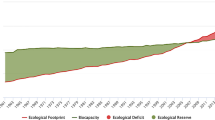Abstract
The human development index (HDI) was an important step toward a more human-oriented assessment of socioeconomic prosperity. Nevertheless, at the onset of the anthropocene, the environmental pillar of sustainable development is indispensable. This work aims to understand this conundrum of human development and its environmental cost or pressure through the use of the planetary pressures–adjusted human development index (PHDI) as well as introduce another modified version, planetary pressures, and inequality-adjusted human development index (PIHDI). PHDI incorporates two biophysical consumption-based indicators (CO2 emissions and material footprint, MF) as a proxy of environmental pressures into traditionally socioeconomic development-focused HDI. This work spans 164 nations and 27 years (1990–2016). Various statistical techniques such as Pearson’s correlation, hierarchical clustering (HCA), generalised additive modelling (GAM), data envelopment analysis (DEA), linear regression, and ARIMA forecasting have been used to explore interrelationships, non-linearity, efficiency analysis, and future projections (up to 2030) and delve into two scenarios: high human development and for human development permitted only within the two planetary boundaries (PBs) (viz. climate change and material footprint) and their consequences when exceeded. Though most of the countries with high PHDI and PIHDI scores are from the global north and have a high income, it is also possible to attain human development (i.e. increase PHDI and PIHDI scores) without overexploiting biophysical resources. From 2016, human development scores could increase by 55–63% (climate change) or 30–46% (material consumption) within a safe operating space in 2030. Without the required focus on the environment, aiming for a superior score in PHDI and PIHDI could result in 43–58% (CO2 emissions) or 57–58% (material footprint) of countries that would exceed PB. Based on the outcome of this work, it can be recommended that governments and policymakers that it is well within the limits of feasibility as well as necessary to make human socioeconomic development aspire to sustainability to address the needs of humanity, while respecting the well-being of the surrounding biosphere.






Similar content being viewed by others
Data availability statement
The authors confirm that the data, used in this study, are available in public databases, such as Global Carbon Project, UNEP, HDRO, UN DESA etc.
References
Assa J (2021) Less is more: the implicit sustainability content of the human development index. Ecol Econ 185:107045. https://doi.org/10.1016/j.ecolecon.2021.107045
Biggeri M, Mauro V (2018) Towards a more ‘sustainable’ human development index: Integrating the environment and freedom. Ecol Indic 91:220–231. https://doi.org/10.1016/j.ecolind.2018.03.045
Bravo G (2014) The human sustainable development index: new calculations and a first critical analysis. Ecol Indic 37:145–150. https://doi.org/10.1016/j.ecolind.2013.10.020
Bringezu S (2015) Possible target corridor for sustainable use of global material resources. Resources 4:25–54. https://doi.org/10.3390/resources4010025
Comes CA (2015) HSDSI analysis for EU 28 countries. Procedia Econ Financ 32:154–159. https://doi.org/10.1016/S2212-5671(15)01377-5
Dittrich M, Giljum S, Lutter S, Polzin C (2012) Green economies around the world? Implications of resource use for development and the environment. Sustainable Europe Research Institute (SERI). (Available from https://www.greengrowthknowledge.org/research/green-economies-around-world-implications-resource-use-development-and-environment, accessed on 19th April 2022)
Ehrenstein M, Calvo-Serrano R, Galan-Martín A, Pozo C, Zurano-Cervello P, Guillen-Gosalbez G (2020) Operating within planetary boundaries without compromising well-being? A data envelopment analysis approach. J Clean Prod 270:121833. https://doi.org/10.1016/j.jclepro.2020.121833
Ensor J, Hoddy E (2021) Securing the social foundation: a rights-based approach to planetary boundaries. Earth System Governance 7:100086. https://doi.org/10.1016/j.esg.2020.100086
Fanning AL, O’Neill DW, Hickel J, Roux N (2022) The social shortfall and ecological overshoot of nations. Nat Sustain 5(1):26–36. https://doi.org/10.1038/s41893-021-00799-z
Global Carbon Project (2020) Global carbon atlas. http://www.globalcarbonatlas.org/en/CO2-emissions (accessed on 19th April 2022)
Gorobets A (2011) The global systemic crisis and a new vision of sustainable human development. Environ Dev Sustain 13(4):759–771. https://doi.org/10.1007/s10668-011-9288-6
Gupta J, Liverman D, Bai X, Gordon C, Hurlbert M, Inoue CYA, Jacobson L, Kanie N, Lenton TM, Obura D, Otto IM (2021) Reconciling safe planetary targets and planetary justice: why should social scientists engage with planetary targets? Earth System Governance 10:100122. https://doi.org/10.1016/j.esg.2021.100122
Hastie TJ, Tibshirani RJ (1990) Generalized additive models. Routledge, NY. eBook ISBN: 9780203753781
HDR (1990) Human development report 1990: concept and measurement of human development. New York. (http://www.hdr.undp.org/en/reports/global/hdr1990, accessed on 19th April 2022)
HDR (2020) Human Development Report 2020. The next frontier: human development and the anthropocene. New York. http://hdr.undp.org/en/content/human-development-report-2020
Hermele K (2006) Greening the human development index. In: Hornoborg A, Jorgensen AK (eds) International trade and environmental justice: toward a global political ecology. Nova Science Publishers, Inc. Available from https://lucris.lub.lu.se/ws/portalfiles/portal/5629497/1546292.pdf. Accessed 19 April 2022
Hickel J (2020) The sustainable development index: measuring the ecological efficiency of human development in the anthropocene. Ecol Econ 167:106331. https://doi.org/10.1016/j.ecolecon.2019.05.011
Ivanov A, Peleah M (2017) sustainable human development index-a pragmatic proposal for monitoring sustainability within the affordable limits. In IARIW-Bank of Korea Conference ‘Beyond GDP: Experiences and Challenges in the Measurement of Economic Well-being’, Seoul, Korea. (Available from http://old.iariw.org/korea/peleah.pdf, accessed on 19th April 2022)
Jain P, Jain P (2013) Sustainability assessment index: a strong sustainability approach to measure sustainable human development. Int J Sustain Dev World Ecol 20(2):116–122. https://doi.org/10.1080/13504509.2013.766910
Jin H, Qian X, Chin T, Zhang H (2020) A global assessment of sustainable development based on modification of the human development index via the entropy method. Sustainability 12(8):3251. https://doi.org/10.3390/su12083251
Jouffray JB, Blasiak R, Norström AV, Österblom H, Nyström M (2020) The blue acceleration: the trajectory of human expansion into the ocean. One Earth 2(1):43–54. https://doi.org/10.1016/j.oneear.2019.12.016
Krausmann F, Gingrich S, Eisenmenger N, Erb KH, Haberl H, Fischer-Kowalski M (2009) Growth in global materials use, GDP and population during the 20th century. Ecol Econ 68(10):2696–2705. https://doi.org/10.1016/j.ecolecon.2009.05.007
Lenton TM (2013) Environmental tipping points. Annu Rev Environ Resour 38:1–29. https://doi.org/10.1146/annurev-environ-102511-084654
Lucas PL, Wilting WC, Hof AF, van Vuuren DP (2020) Allocating planetary boundaries to large economies: distributional consequences of alternative perspectives on distributive fairness. Glob Environ Change 60:102017. https://doi.org/10.1016/j.gloenvcha.2019.102017
O’Neill DW, Fanning AL, Lamb WF, Steinberger JK (2018) A good life for all within planetary boundaries. Nat Sustain 1:88–95. https://doi.org/10.1038/s41893-018-0021-4
Otto IM, Donges JF, Cremades R, Bhowmik A, Hewitt RJ, Lucht W, Rockström J, Allerberger F, McCaffrey M, Doe SSP, Lenferna A, Morán N, van Vuuren DP, Schellnhuber JH (2020) Social tipping dynamics for stabilizing Earth’s climate by 2050. Proc Natl Acad Sci USA 117(5):2354–3236. https://doi.org/10.1073/pnas.1900577117
Persson L, Almroth C, Collins CD, Cornell SE, de Wit C et al (2022) Outside the safe operating space of the planetary boundary for novel entities. Environ Sci Technol 56(3):1510–1521. https://doi.org/10.1021/acs.est.1c04158
Pickering J, Persson Å (2020) Democratising planetary boundaries: Experts, social values and deliberative risk evaluation in Earth system governance. J Environ Policy Plan 22(1):59–71. https://doi.org/10.1080/1523908X.2019.1661233
Pineda J (2012) Sustainability and human development: a proposal for a sustainability adjusted HDI (SHDI). MPRA Paper No. 39656, (Available at https://mpra.ub.uni-muenchen.de/39656/) (accessed on 19th April 2022)
Randers J, Rockström J, Stoknes PE, Golüke U, Collste D, Cornell SE (2018) Transformation is feasible: how to achieve the sustainable development goals within planetary boundaries. A report to the Club of Rome from Stockholm Resilience Centre and BI Norwegian Business School. (Available from https://www.clubofrome.org/publication/transformation-is-feasible/, accessed on accessed on 19th April 2022)
Raworth K (2017) A doughnut for the Anthropocene: humanity’s compass in the 21st century. Lancet Planet Health 1(2):e48–e49. https://doi.org/10.1016/S2542-5196(17)30028-1
Ray M (2014) Redefining the human development index to account for sustainability. Atl Econ J 42(3):305–316. https://doi.org/10.1007/s11293-014-9424-4
Rockström J, Gupta J, Lenton TM, Qin D, Lade SJ, Abrams JF, Jacobson L, Rocha JC, Zimm C, Bai X, Bala G (2021) Identifying a safe and just corridor for people and the planet. Earth's Future, 9 (4), e2020EF001866. https://doi.org/10.1029/2020EF001866
Rogelj J, Forster PM, Kriegler E, Smith CJ, Séférian R (2019) Estimating and tracking the remaining carbon budget for stringent climate targets. Nature 571(7765):335–342. https://doi.org/10.1038/s41586-019-1368-z
Roy A, Pramanick K (2019) Analysing progress of sustainable development goal 6 in India: past, present, and future. J Env Manage 232:1049–1065. https://doi.org/10.1016/j.jenvman.2018.11.060
Roy A, Pramanick K (2020) Safe and just operating space for India. In Hussain CM (ed) Handbook of modern environmental materials management. Springer Nature Switzerland AG. https://doi.org/10.1007/978-3-319-58538-3_210-1
Roy A, Li Y, Dutta T, Basu A, Dong X (2022) Understanding the relationship between globalization and biophysical resource consumption within safe operating limits for major Belt and Road Initiative countries. Environ Sci Pollut Res 29:40654–40673. https://doi.org/10.1007/s11356-022-18683-4
Seckler M, Volkert J (2021) The capability approach: a promising foundation for sustainable development? Ecol Econ 183:106951. https://doi.org/10.1016/j.ecolecon.2021.106951
Sen A (2000) A decade of human development. J Hum Dev 1(1):17–23. https://doi.org/10.1080/14649880050008746
Steffen W, Broadgate W, Deutsch L, Gaffney O, Ludwig C (2015) The trajectory of the Anthropocene: the great acceleration. Anthr Rev 2(1):81–98. https://doi.org/10.1177/2053019614564785
Steffen W, Rockström J, Richardson K, Lenton TM, Folke C, Liverman D, Summerhayes CP, Barnosky AD, Cornell SE, Crucifix M, Donges JF, Fetzer I, Lade SJ, Scheffer M, Winkelmann R, Schellnhuber HJ (2018) Trajectories of the earth system in the Anthropocene. Proc Natl Acad Sci USA 115(33):8252–8259. https://doi.org/10.1073/pnas.1810141115
Türe C (2013) A methodology to analyse the relations of ecological footprint corresponding with human development index: eco-sustainable human development index. Int J Sustain Dev World Ecol 20(1):9–19. https://doi.org/10.1080/13504509.2012.751562
Ul Haq M (1995) Reflections on human development. Oxford University Press, New York
UNDP (2022) New threats to human security in the Anthropocene: demanding greater solidarity. UN Dev. Program
UNEP (2012) The emissions gap report 2012, Nairobi
UNEP (2020) The emissions gap report 2020, Nairobi.
Van den Bergh JC, Grazi F (2014) Ecological footprint policy? Land use as an environmental indicator. J Ind Ecol 18(1):10–19. https://doi.org/10.1111/jiec.12045
World Atlas (2022). Continents by number of countries. (Available from https://www.worldatlas.com/geography/continents-by-number-of-countries.html, accessed on 1st October 2022)
Zhang S, Zhu D (2022) Incorporating “relative” ecological impacts into human development evaluation: planetary boundaries–adjusted HDI. Ecol Indic 137:108786. https://doi.org/10.1016/j.ecolind.2022.108786
Funding
This research was supported by the Natural Science Foundation of China (Nos. 42171149 and 41901222).
Author information
Authors and Affiliations
Contributions
Conceptualization: AR, XD; data curation: AR; methodology: AR, XD; investigation: AR; formal analysis: AR, TD; software: AR, TD; interpretation: AR, XD; resources: AR; project administration: YL, XD; writing (original draft preparation): AR; writing (review and editing): AR, YL, XD; visualisation: AR, TD; supervision: YL, XD; funding acquisition: XD.
Corresponding author
Ethics declarations
Ethical approval
Not applicable. Based on datasets from international public databases.
Consent to participate
Not applicable.
Consent for publication
Not applicable.
Competing interests
The authors declare no competing interests.
Additional information
Responsible Editor: Philippe Garrigues
Publisher's note
Springer Nature remains neutral with regard to jurisdictional claims in published maps and institutional affiliations.
Supplementary Information
Below is the link to the electronic supplementary material.
Rights and permissions
Springer Nature or its licensor (e.g. a society or other partner) holds exclusive rights to this article under a publishing agreement with the author(s) or other rightsholder(s); author self-archiving of the accepted manuscript version of this article is solely governed by the terms of such publishing agreement and applicable law.
About this article
Cite this article
Roy, A., Dutta, T., Li, Y. et al. Human development at the cost of the environment?—an application of planetary pressures–adjusted human development index in the lens of planetary boundaries. Environ Sci Pollut Res 30, 32383–32405 (2023). https://doi.org/10.1007/s11356-022-24399-2
Received:
Accepted:
Published:
Issue Date:
DOI: https://doi.org/10.1007/s11356-022-24399-2




